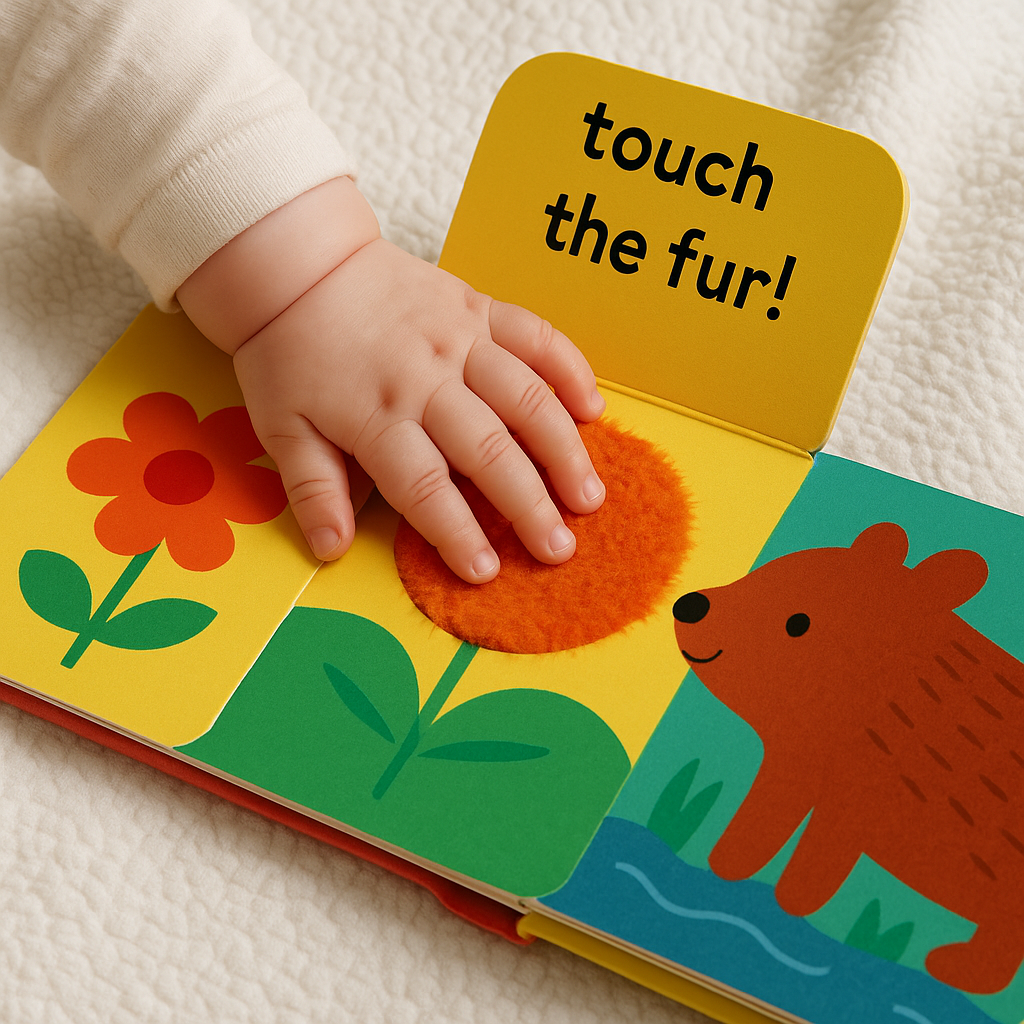Babies who miss interactive story-time hear up to 1 million fewer words before kindergarten. Five playful tweaks can close that gap and turn every reading session into a brain-building game—even for the wiggliest listener.
- Why does interactive story-time supercharge your baby’s brain development?
- Which dramatic voice tricks keep tiny listeners glued to the story?
- How can letting your baby take the lead turn pages into conversation?
- Which props and movements transform a simple story into playful theater?
- Why do touch-and-feel or lift-the-flap books make story-time irresistible?
- How do you keep the story alive after the book closes?
- What if your baby is wiggly, bilingual, or has sensory needs?
- Quick answers to parents’ top interactive story-time questions
- Final Thoughts: Ready to turn the page together?
Why does interactive story-time supercharge your baby’s brain development?
Interactive story-time engages multiple senses, making it more than just reading. Pairing words with eye contact, gestures, and touch doubles word exposure compared to reading aloud. This approach activates auditory, visual, and social-emotional brain regions, building language and empathy skills.
Research highlights its impact. Zero to Three notes that reading from birth boosts language development. For bilingual families, story-time in both languages enhances cognitive skills like executive function, leading to better proficiency in each language, per Bilingualism in Early Years.
For a deeper dive into the science of talk and brain wiring, visit How Talking to Your Baby Boosts Language and Brain Skills.

Which dramatic voice tricks keep tiny listeners glued to the story?
To captivate babies during storytime, use these dramatic voice tricks:
- Vary pitch and tempo: Switch between high and low tones or speed up and slow down to hold attention. Babies love the sing-song rhythm of “parentese” over flat speech, as it aids language learning.
- Add onomatopoeia: Sounds like “woof,” “vroom,” or “splash” spark phonological awareness, making words memorable.
- Use expressive volume: Whisper for suspense or boom for excitement to keep babies engaged.
- Try echo reading: Pause after a line, like “The cow says…,” letting your baby babble back. This builds conversational skills.
These techniques make stories lively, encouraging focus and early language development, even for the wiggliest listeners. Need more on baby-friendly speech? See Parentese: How Baby Talk Boosts Language Skills.
How can letting your baby take the lead turn pages into conversation?
Letting your baby take the lead during story-time transforms reading into a conversational, brain-building experience. Here’s how:
- Offer choices: Present two books and let your baby pick one. This autonomy can boost attention by up to 40%, as it fosters engagement and decision-making.
- Follow their cues: Allow grabbing, mouthing, or skipping pages. These actions are early communication attempts, signaling curiosity or preferences.
- Pause for responses: After questions like “Where’s the puppy?” wait three seconds. This gives your baby time to point, smile, or babble, encouraging expressive language.
- Respond to gestures: If they point or vocalize, acknowledge it with words like “Yes, that’s the dog!” This mimics conversation, reinforcing turn-taking.
For more on early language development, explore Zero to Three: Supporting Language and Literacy Skills.

Which props and movements transform a simple story into playful theater?
Props and movements turn story-time into an engaging, three-dimensional experience that boosts your baby’s learning and recall. Here’s how to make stories come alive:
- Use matching props: Pair a plush duck with “Five Little Ducks” or a toy car with a vehicle story. These tangible objects connect words to real-world items, enhancing understanding.
- Incorporate motion: Bounce your baby gently during “Row, Row, Row Your Boat” or sway for a windy scene in “The Very Hungry Caterpillar.” Kinesthetic actions link words to physical sensations, improving memory.
- Add simple accessories: Wave a scarf to mimic wind or use finger puppets for characters. A small box of household items like toy animals or fabric scraps becomes a versatile story kit.
- Encourage participation: Hand your baby a prop to hold or shake, like a rattle for a noisy story moment, fostering active involvement. Check Baby Sign Language: Boosting Communication Early.
For more ideas, check out Interactive Storytime Props.
Why do touch-and-feel or lift-the-flap books make story-time irresistible?
Touch-and-feel or lift-the-flap books captivate babies by engaging multiple senses, making story-time a rich, interactive experience. Here’s why they’re irresistible:
- Sensory Engagement: Textured patches (e.g., fuzzy or bumpy surfaces), flaps, or mirrors stimulate touch receptors, extending attention spans. Check Touch and Feel Benefits notes these books boost comprehension and reading enthusiasm by activating sensory pathways.
- Fine-Motor Development: Lifting flaps or tracing textures hones fine-motor skills, encouraging coordination as babies explore.
- Visual Appeal: High-contrast images and interactive elements suit newborn vision, keeping eyes focused. Books like “Pat the Bunny” or “Where’s Spot?” invite repeated exploration.
- Interactive Fun: Flaps and textures turn reading into a game, encouraging babies to anticipate surprises, which strengthens memory and vocabulary.
These features make sensory books a powerful tool for holding attention and fostering early learning, perfect for even the wiggliest listeners.

How do you keep the story alive after the book closes?
Extending the story beyond the book reinforces learning and weaves it into daily life. Here are practical ways to keep the magic going:
- Incorporate Play: Act out story themes, like stirring pretend soup after a cooking tale or mimicking animal sounds from a farm book. This connects words to actions, boosting recall.
- Use Story Lines in Routines: Quote favorite lines, such as “Goodnight Moon” before naps, or sing a story’s song during diaper changes. Repetition builds familiarity and comfort.
- Create Story-Related Activities: Set up a simple sensory bin with toys matching the story (e.g., plastic animals for a zoo book) to encourage exploration.
- Encourage Imitation: Ask your baby to mimic gestures from the story, like clapping for a happy scene, reinforcing language through movement.
It strengthens your baby’s language skills and keep the joy of story-time alive, fostering a love for learning; see When to Start Reading to Your Baby: A Guide for Parents.
What if your baby is wiggly, bilingual, or has sensory needs?
Tailoring interactive story-time to your baby’s unique needs ensures it remains engaging and effective. Here’s how to adapt for wiggly, bilingual, or sensory-sensitive babies:
- Wiggly Movers: For babies who can’t sit still, read while baby-wearing or during stroller walks to channel their energy. Choose sturdy board books under 10 pages for quick, engaging sessions. Short bursts of reading keep it fun without overwhelming them.
- Bilingual Families: Alternate languages page by page to expose your baby to both. A 2018 study shows bilingual story-time enhances vocabulary and cognitive skills like executive function as per Bilingualism in the Early Years. Mixing languages fosters fluency and cultural connection.
- Sensory-Sensitive Infants: Dim lights to reduce stimulation and use soft-fabric books to avoid overwhelming textures. Read in a slow, rhythmic voice to soothe rather than startle. These adjustments create a calm, comforting experience.
For more on early literacy, visit Zero to Three: Supporting Language and Literacy Skills.
Quick answers to parents’ top interactive story-time questions
-
Should I finish the whole book if my baby loses interest?
Stop happily and return later; positive vibes beat completion. A cheerful pause prevents frustration and keeps books fun. -
How long should a session last?
Aim for 3–5 minutes with newborns, up to 10 by 18 months. Several mini-reads outperform one marathon. -
Is digital reading okay?
Shared e-books are fine, but tactile print offers richer sensory input. Balance screens with page turning; see Screen Time and Speech Delay. -
What if my baby only wants one book?
Embrace the repeat. Familiar stories strengthen memory, prediction skills, and comfort.
Final Thoughts: Ready to turn the page together?
Interactive story-time—rich voices, baby choices, playful props, sensory pages, and real-world follow-ups—closes the million-word gap and sparks lifelong curiosity. Join our printable 5-Day Storytime Challenge and keep exploring in Reading to Your Baby: Boosting Language from Birth. Every giggle, babble, and page flip today wires your baby’s brain for tomorrow’s learning and love.